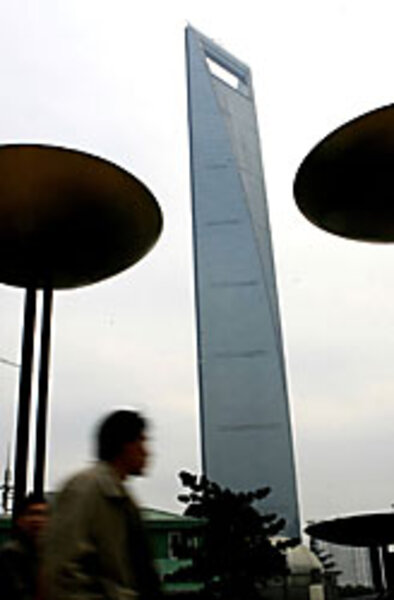In China, empty office spaces fill the sky
Loading...
| SHANGHAI, CHINA
As dusk falls on Shanghai's futuristic skyline, spotlights blaze on its newest and tallest landmark. Fairy lights dance around the trapezoid opening at the top of the Shanghai World Financial Center (SWFC). Depending on where you stand, the Japanese-designed tower, the world's second tallest, looks like a giant bottle opener or a knife slicing the foggy skies.
But behind the glitter is an awkward truth: The lights are on, but almost nobody is home.
A global credit meltdown and a slowing domestic economy conspired to ruin the coming-out party for this and other newly built skyscrapers, part of a Chinese real-estate boom that has lost its allure. New homes lack buyers and high-rise offices lack renters, depressing prices and forcing developers in Shanghai and other cities to mothball projects as financing dries up.
Since October, China's government has responded by slashing interest rates, sweetening mortgage terms, and adding low-cost housing to its two-year economic stimulus plan. Authorities are also arm-twisting banks to keep lending to domestic industries.
But a glut of completed commercial and residential property will likely prove hard to shift in a climate of caution. Nor does the stimulus package offer much relief for real-estate companies exposed to the sudden downturn.
"Some developers will definitely go bankrupt. It happened before. The government will probably want bigger companies to take the [failing] companies over," says Vincent Gu, assistant general manager of property sales at K Wah Investment, a real-estate developer in Shanghai.
A real-estate crash in China doesn't pose the catastrophic risk of a US-style credit crunch. That's because Chinese banks haven't binged on property lending: Only 20 percent of outstanding loans are in real estate, either in the form of mortgages or credit to developers, according to the World Bank. Around half of apartment sales in Shanghai are done in cash, says Mr. Gu.
Banks also have a big cushion in terms of capital, so a spike in bad loans is unlikely to sink them. But local authorities will be hit hard, as they depend heavily on property taxes and land sales. Under the stimulus plan, local counties, cities, and towns are supposed to pump up spending to supplement money from Beijing.
"Over half of the revenues of local governments come from the property sector, so they were pushing really hard to build more. Eventually, you hit a wall," says Andy Xie, an independent economist in Shanghai.
Few pushed harder than Pudong, the district of Shanghai that was transformed in the 1990s from farmland into a financial hub designed to rival, if not surpass, Wall Street. Multinational firms seeking office space were aggressively courted, often at the expense of Chinese companies. Rents soared as the world flocked to China, and developers scrambled to meet demand.
That red-hot demand is now cooling just as a spurt of shiny new buildings fling open their doors. As a result, occupancy rates in Pudong's commercial center recently sank to their lowest level since 2004 and that trend is set to continue, possibly into 2010. (Editor's note: The original version misstated the trend in occupancy rates.)
"Even without the financial crisis, Shanghai's office market was slated for a correction," says Hingyin Lee, director of research in Shanghai at Colliers International, a property consultancy and agent. "This [crisis] will lengthen and deepen the correction."
The SWFC opened in August, having signed up a slate of clients willing to pay for the most prestigious address in Shanghai. A Park Hyatt hotel – the world's tallest – begins at the building's 79th floor with rooms starting from $400.
Among those must-have clients was Lehman Brothers, just weeks away from bankruptcy. Several other international companies have also broken their leases, say property agents. Estimates of the SWFC's occupancy rate range from 20 percent to 40 percent.
Shanghai's boosters point out that their city, a capitalist crucible since the 19th century, was virtually built on land speculation and knows how to survive through booms and busts. In 2005, residential sales slumped as Beijing sought to deflate a real-estate bubble in this and other boomtowns. That effort largely succeeded, so there is an expectation that a fiscal boost can revive the market. Property agents also point to Shanghai's hosting of the 2010 World Expo as a growth driver.
Steep discounts will probably entice back home buyers, as there is pent-up demand for urban housing in China. Unlike in the US, where consumers are saddled by debt, Chinese customers are more concerned with spending their savings wisely, says Mr. Xie, the economist. "This is the difference between China and the US. In China, with lower prices there will be demand," he says.
On a vacant city block behind the SWFC (1,614 feet), construction has begun on a rival Chinese-financed skyscraper. The Shanghai Tower is designed to surpass it by reaching 2,073 feet, also beating out Taiwan's Taipei 101, currently the world's tallest building. Its completion due date is 2014 – in time for the next global bull market.





